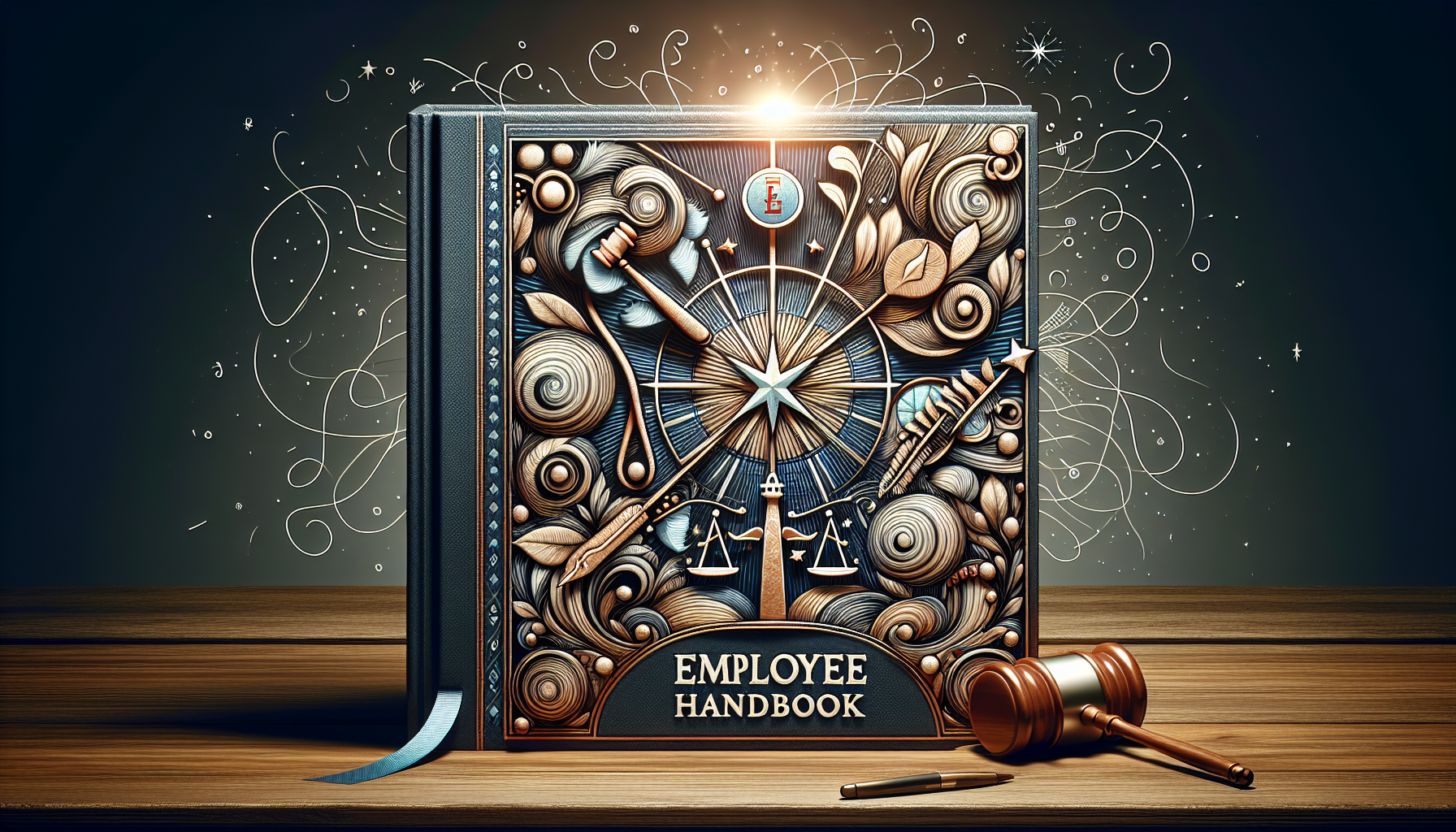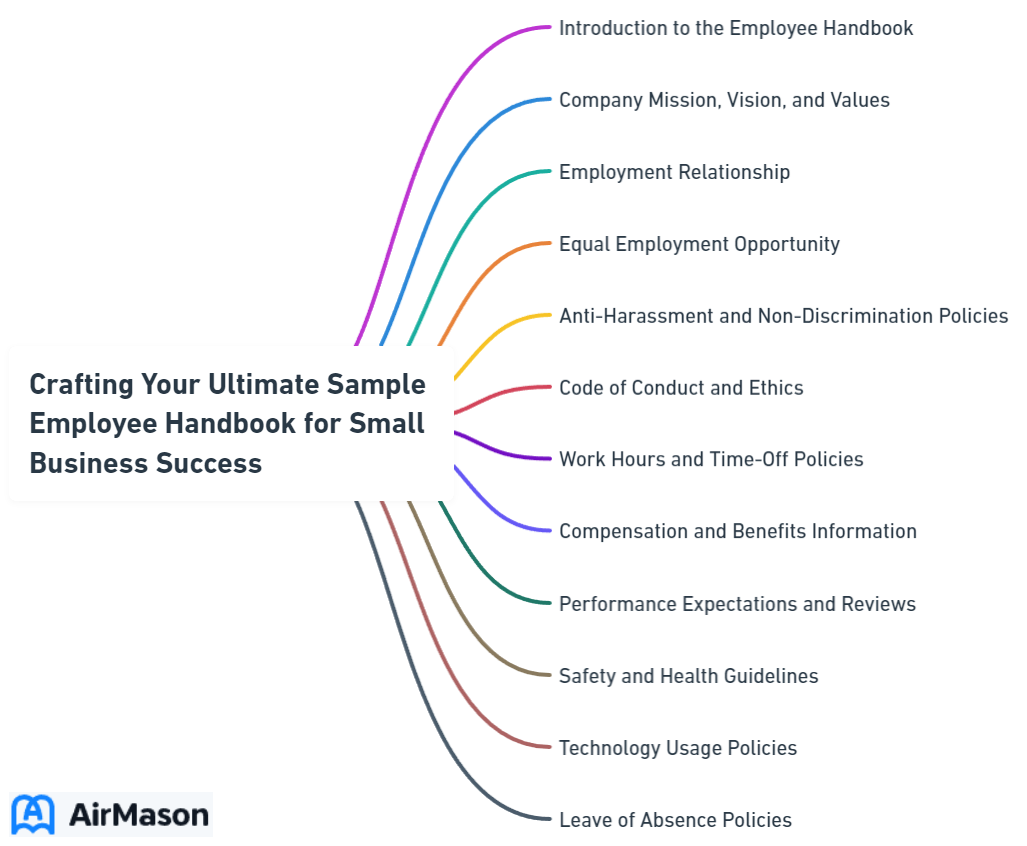
Are you starting or optimizing a small business and need a solid Sample Employee Handbook for Small Business? This guide provides essential elements and clear explanations to help you construct your own employee handbook, highlighting key issues like workplace policies and legal requirements. Our aim is simple: to equip you with the knowledge to build a comprehensive guide for your team that aligns with your small business values and legal obligations.
Key Takeaways
- An effective employee handbook is a comprehensive guide that sets expectations, outlines company policies, and ensures legal compliance, requiring regular updates as the company evolves.
- The employee handbook should begin with a welcoming introduction that sets the tone for the company culture and include detailed sections on employment policies, workplace conduct, compensation, benefits, and leave policies to provide clear guidelines for employees.
- Performance and discipline procedures, safety and compliance protocols, termination/resignation processes, and a mandatory employee acknowledgment receipt should be included in the handbook and reviewed regularly with legal experts for continuous alignment with updated laws.
Decoding the Sample Employee Handbook

The employee handbook functions as a roadmap. This crucial communication tool delineates company policies, sets employee expectations, and facilitates compliance with pertinent legal requirements. An effective employee handbook should not only communicate the company’s policies but also reflect its goals and objectives while adhering to applicable laws and regulations. It’s essentially the DNA of your company, providing a blueprint for employee behavior, engagement and training.
The question arises, how do you craft an employee handbook that is comprehensible, well-structured, and preemptively resolves potential conflicts and misunderstandings about company policies and legal obligations? The solution lies in leveraging the expertise of legal professionals. They can help you decode the intricacies of employment laws and craft an employee handbook template that meets both the employer’s and employees’ needs.
Consider the employee handbook as a living document. As business needs evolve, the handbook should be updated to reflect changes in company policies, workplace environment, and employment laws. Remember, an informed employee is an engaged employee. The ultimate goal of your handbook should be to provide employees with a clear understanding of what the employer expects from them and what they can expect from their employer.
In essence, an effective employee handbook is your company’s compass, guiding new hires and existing employees alike through the employment basics, company culture, and company policies. Employee handbooks are an investment that pays dividends in terms of employee engagement, workplace harmony, and legal compliance.
Crafting Your Welcome Section
Just like every journey commences with a single step, the creation of an employee handbook starts with the welcome section. This section represents your initial opportunity to create a positive impression on your new employees, thus getting it right is paramount. The welcome message should be sincere, friendly, and convey genuine excitement about new employees joining the team.
The welcome section sets the stage for the company’s culture, core values, and mission statement. It should avoid a transactional tone and instead focus on making the workplace exciting and showing how employees contribute to the company’s success. Remember, first impressions matter. The welcome section is more than just a mere formality; it’s an opportunity to establish an emotional connection with your new employees right from the start.
When crafting the welcome message, consider personalizing it. Here are some tips:
- Address the new employee by name
- Refer to their role or background
- Keep the message brief and upbeat
- Assure them of support
- Express a hearty welcome to the team
This personal touch can go a long way in making your new hires feel valued and excited about their journey with your company, as it demonstrates your commitment to upholding company values.

Outlining Employment Policies and Classifications
Having set a welcoming tone, we can now delve into the core of the employee handbook – the employment policies and classifications. This section is where you define the various employment classifications in your organization and outline the rules around work hours, overtime, and the concept of at-will employment. This is crucial to prevent employee misclassification and ensure compliance with the Fair Labor Standards Act (FLSA).
Defining employment policies and classifications is not just about legal compliance; it’s also about transparency and equal employment opportunity. By clearly outlining these policies, you help employees understand their rights, obligations, and the nature of their employment relationship with the company. This understanding is key to fostering a positive workplace environment and promoting employee engagement.
Let’s now delve into the specifics of defining work hours and overtime, and explaining the concept of at-will employment. These sub-sections will provide more granular details on these critical employment policies and ensure that your employee handbook covers all bases.
Defining Work Hours and Overtime

In defining work hours and overtime, accuracy and clarity hold the key. The employee handbook should specify employee work hours, detail expected business hours, and outline a clock-in/out procedure. This not only ensures transparency but also helps establish norms around work hours, helping to create a more predictable and efficient work environment.
But what happens when work extends beyond the regular hours? This is where your overtime policy comes into play. The employee handbook should explain the process for approving overtime work, ensuring that overtime is managed and authorized appropriately. This will prevent misunderstandings and disputes over overtime work and ensure that employees who put in extra hours are compensated accurately and fairly.
In terms of compensation, it is noteworthy that the calculation of overtime wages for eligible employees should adhere to federal and state laws. The employee handbook must detail this computation method. This information is crucial for employees to understand their rights and the company’s obligations, promoting trust and transparency.
In essence, defining work hours and overtime is about setting clear expectations and creating a fair and predictable work environment. This not only helps in maintaining compliance with labor laws but also contributes to employee satisfaction and productivity.
At-Will Employment Explained
The concept of at-will employment is fundamental to employment in the United States. It means that employees can resign at any time for any reason, and similarly, the employer can terminate an employee’s employment at any time for any lawful reason. Sounds simple, right? Well, it’s not that straightforward.
There are exceptions to the at-will employment doctrine, including situations such as written employment contracts, implied contracts in policy manuals, or violations of public policy constraints. Furthermore, whistle-blower protections and specific statutes may prevent at-will termination for certain employees. Therefore, it’s crucial to explain the concept of at-will employment in your handbook, its exceptions, and how it affects the employment relationship.
The at-will employment policy is immutable and can only be altered through a signed, written agreement between the employer and the employee. The employee handbook should include an affirmation that the handbook is not an employment contract, maintaining the integrity of the at-will employment relationship. This not only clarifies the nature of the employment relationship but also helps mitigate legal risks for the company.
Understanding and communicating the concept of at-will employment is pivotal to maintaining clarity and fairness in the employer-employee relationship. By adequately explaining this concept in your employee handbook, you ensure that both the employer and employees understand their rights and responsibilities, fostering a healthy work environment.
Sample Employee Handbook PDF
If you’re seeking a comprehensive guide to crafting your company’s policies and procedures, a sample employee handbook PDF can serve as an invaluable resource. This document provides a structured framework outlining rules, expectations, and benefits for employees within an organization. A well-constructed handbook not only communicates company policies clearly but also helps in fostering a positive workplace culture and mitigating legal risks. By offering insights into various sections such as employment policies, code of conduct, benefits, and disciplinary procedures, a sample employee handbook PDF can serve as a reference point for HR professionals and business owners alike. Furthermore, it allows for customization to align with the specific needs and values of your organization, ensuring that it reflects your company’s unique identity and priorities. Whether you’re establishing guidelines for a small startup or updating policies for a large corporation, utilizing a sample employee handbook PDF can streamline the process and provide a solid foundation for effective HR management.
Establishing Clear Workplace Conduct Guidelines

The employee handbook is not just about policies and procedures; it’s also about fostering a company culture that promotes uniformity and fairness. A robust employee handbook lays the groundwork for consistent application of conduct policies. But how do you establish clear workplace conduct guidelines?
Firstly, recognizing the handbook’s role in fostering a productive workplace environment is of critical importance. It enforces compliance with established rules and standards of conduct. This creates a sense of order and discipline in the workplace, contributing to a positive work culture.
The employee handbook should contain explicit sections on workplace safety, anti-discrimination, and harassment prevention. This not only ensures legal compliance but also shows the company’s dedication to a harassment-free environment. In addition, the handbook must clearly articulate the company’s dress code policy and define personal conduct policies regarding workplace relationships and employee interactions. Policies regarding the abuse of substances, including alcohol and illegal drugs, are also essential.
Lastly, the handbook should specify how employees should address solicitations and distributions within the workplace. This contributes to overall safety and order. By establishing clear workplace conduct guidelines, you create a fair and consistent work environment that promotes respect and professionalism among employees.
Communicating Compensation and Benefits
The section on compensation and benefits is a vital element of the employee handbook. This is where you clearly outline compensation structures, benefits, and eligibility requirements. In doing so, employees are enabled to comprehend and fully leverage the perks offered by the company.
Whether it’s detailing salary and wage information or summarizing employee benefits, clear and transparent communication is key. Employees must understand how their compensation is structured and the various employee benefits such as health insurance and retirement plans that are available to them. This not only helps employees to make informed decisions about their compensation and benefits but also shows them the monetary and non-monetary investments that the company makes in them.
In addition to this, it’s essential to establish the conditions under which employees receive payment for time off. This ensures clarity on PTO policies. However, while communicating compensation and benefits, it’s important to include a disclaimer. This should state that in the case of any inconsistencies, the formal plan documents prevail over the handbook descriptions.
Detailing Salary and Wage Information
When it comes to communicating compensation, clarity is paramount. Employee compensation can be disbursed on a weekly, bi-weekly, or monthly basis. The chosen payment schedule should be clearly stated in the employee handbook, ensuring all employees are informed of when to expect their compensation.
Providing this information not only helps employees plan their finances but also fosters transparency and trust. Remember, compensation is not just about the paycheck; it’s a reflection of the company’s commitment to its employees. Therefore, detailing salary and wage information in a clear and comprehensive manner is crucial to maintaining a positive employee-employer relationship.
Summarizing Employee Benefits
Apart from salary, employee benefits are a major part of an employee’s compensation package. Therefore, providing an overview of employee benefits is essential. Here are some key benefits to include in the employee handbook:
- Health insurance: Outline eligibility, coverage details, effective dates, and dependent options.
- Retirement plans: Communicate options such as 401(k) or pension plans, conditions for eligibility, employer contributions, and instructions for managing retirement funds when changing jobs or retiring.
- Life insurance: Explain the coverage provided and any additional options available.
- Additional perks: Include any other benefits offered by the company, such as flexible work hours, paid time off, or employee discounts.
By including these details in the employee handbook, you ensure that employees have a clear understanding of the benefits they are entitled to.
Employees should also be informed about:
- Employer-provided life insurance policies
- Disability insurance coverage
- Perks such as performance-based bonuses or commissions
- The tax implications of benefits extended to domestic partners
Additionally, these details must be explained within your own employee handbook, and referring to employee handbook examples can be helpful in ensuring clarity and understanding. It’s essential to note that employee handbook outlines play a crucial role in organizing the information effectively.
By summarizing employee benefits in a clear and concise manner, you help employees understand their benefits and eligibility, enabling them to make informed decisions about their benefits.
Employee Handbook UK
An employee handbook UK serves as a comprehensive guide for both employers and employees, outlining policies, procedures, and expectations within the context of UK employment law. It provides essential information regarding company policies such as employee conduct, benefits, leave policies, and disciplinary procedures, ensuring consistency and clarity across the organization. Additionally, the handbook typically includes legal requirements such as health and safety regulations, equal opportunity policies, and data protection guidelines to ensure compliance with UK employment regulations. This document serves as a reference point for both new hires and existing employees, helping them understand their rights, responsibilities, and the company’s culture. Regular updates to the handbook are necessary to reflect any changes in legislation or company policies, ensuring it remains a relevant and reliable resource for all stakeholders.
Structuring Leave and Time Off Policies
Work-life balance greatly relies on time off. Therefore, developing comprehensive leave policies that comply with federal and state laws, as well as state and local laws, is crucial. Leave policies should include various types of paid and unpaid options, such as:
- Sick days
- Personal days
- Vacation days
- Federally protected leaves like FMLA and disability leave
It’s also important to define paid time off (PTO) accrual and rollover policies. This includes presenting details regarding employee eligibility and clarifying if unused days off may be carried into the next year or are subject to a use-it-or-lose-it rule. Establishing rules for submitting time off requests, including advance notice requirements and any blackout dates when time off cannot be granted, will help maintain order and fairness.
Furthermore, implementing a standardized time off request form can maintain consistency and fairness in handling leave requests. Having a clear system for managing conflicting time off requests, which might be based on a first-come-first-served approach or take employee seniority into account, can also foster transparency and fairness.
By structuring leave and time off policies in a clear and comprehensive manner, you not only ensure legal compliance but also contribute to a positive work-life balance for your employees.
Developing Performance and Discipline Procedures
Any employee handbook must essentially include:
- Performance and discipline procedures
- A well-structured performance evaluation system to enhance employee performance
- A progressive discipline policy to address undesirable behavior fairly and consistently.
When developing a performance evaluation system, it’s important to:
- Align it with the company’s goals
- Define its role in enhancing employee performance
- Incorporate multiple methods such as KPIs, self-assessments, peer reviews, and manager assessments for a more comprehensive system
- Regularly evaluate the performance system for effectiveness through data analysis and feedback
On the disciplinary side, a progressive discipline policy should include the following:
- A series of escalating steps with provisions to consider offense nature, recurrence, work record, and organizational impact
- Meticulous documentation of all disciplinary actions and providing them to the employee
- An appeals process to allow employees to challenge disciplinary actions
Including these elements can foster fairness and transparency in the disciplinary process, similar to the principles upheld during jury duty.
By developing performance and discipline procedures, you foster a work environment that promotes high performance, fairness, and consistency.
Ensuring Safety and Compliance in the Workplace

In any workplace, safety and compliance are indispensable. The employee handbook should include workplace safety and health guidelines, including OSHA standards for employees in hazardous jobs and maintaining a drug-free workplace. This not only ensures legal compliance but also underscores the company’s commitment to safe working conditions.
The handbook should also provide guidance for the following emergency situations:
- Injuries
- Fires
- Severe weather situations
- Bomb threats
Additionally, security measures should be outlined to ensure overall safety and order in the workplace.
Confidentiality and data protection policies tailored to the company’s business laws must also be outlined for employee adherence. Furthermore, details on workers’ compensation insurance and the process for employees to report injuries and seek treatment should be included in the handbook.
By ensuring safety and compliance in the workplace, you not only protect the company from potential legal issues but also create a safe, secure, and compliant work environment for your employees.
Navigating Termination and Resignation Processes
The employment journey inevitably encompasses termination and resignation. Defining termination and resignation procedures in your employee handbook, including severance pay, notice periods, and constructive dismissal, ensures a smooth and legally compliant process.
Employees wishing to resign should be guided to inform HR or their direct manager. While advance notice isn’t required, a typical two-week notice is preferred. If the company has provided funding for an employee’s tuition or relocation, the handbook should stipulate that the employee must reimburse these costs if they leave the company within a contracted period.
The handbook should also clearly define actions that would be considered constructive dismissal, and strictly prohibit such behavior. After termination, employees who remain in good standing or are laid off should be entitled to references, while those who resign may receive them at the manager’s discretion.
By clearly outlining termination and resignation procedures, you ensure a smooth exit process for departing employees and protect your company from potential legal issues.
Employee Handbook Design
Employee handbook design plays a crucial role in shaping the culture and communication within an organization. When crafting an employee handbook, it’s essential to consider not only the content but also the visual presentation. Effective design elements can enhance readability and engagement, ensuring that employees actually utilize the handbook as a resource. Incorporating company branding, clear formatting, and visually appealing graphics can make the handbook more inviting and user-friendly. Moreover, organizing information logically and providing easy navigation can help employees quickly find the information they need. By prioritizing thoughtful design in the creation of an employee handbook, organizations can foster a more informed and cohesive workplace environment.
Employee Acknowledgement and Receipt

To conclude, every employee handbook should include an acknowledgment form requiring employees’ signatures as confirmation that they received, read, and comprehended the handbook. This not only ensures that your employees are aware of the handbook’s content but also protects the company legally by preventing claims of unawareness.
The acknowledgment form must include a space for the employee’s printed name, signature, and date, along with a statement for the opportunity to ask questions and receive satisfactory answers. A signed acknowledgment by an employee acts as proof that they have received the handbook and indicates their responsibility for knowing its contents, which is crucial for legal purposes.
It’s also important to include a clause in the acknowledgment stating that the handbook may be changed at any time by the HR department. This ensures that the handbook remains flexible and adaptable to any future changes in employment laws or company policies.
Reviewing Legal Aspects with Experts
The creation of an employee handbook is not a one-time endeavor; it’s a continuous process. With employment laws and regulations constantly changing, it’s important to:
- Review the legal aspects of your handbook with experts
- Consult legal professionals or outsource handbook creation to HR firms
- Ensure a customized and compliant employee handbook, suitable for the specific needs of your business
In addition to legal review, consistent updates and clear communication of policy changes are essential to align the employee handbook with evolving laws and internal company policies. Regular legal review and annual audits of the employee handbook are necessary to ensure continuous compliance with changing HR laws.
By regularly reviewing and updating the legal aspects of your employee handbook with experts, you ensure that your handbook remains current, relevant, and compliant with local laws.
Summary
In this blog post, we have journeyed through the process of crafting an ultimate sample employee handbook for small business success. From decoding the purpose of the employee handbook, crafting a warm welcome section, outlining employment policies, establishing clear workplace conduct guidelines, to communicating compensation and benefits, structuring leave and time off policies, developing performance and discipline procedures, ensuring safety and compliance in the workplace, navigating termination and resignation processes, and finally, seeking expert advice on legal aspects.
An employee handbook is no longer a ‘nice-to-have’ but a ‘must-have’ for any small business. It not only sets the stage for clear communication between the employer and employees but also ensures legal compliance and aligns everyone with the company’s goals. So, equip yourself with the knowledge shared in this post and start crafting your own employee handbook. Remember, a well-crafted handbook is not just a document; it’s a compass guiding your employees towards success!
Frequently Asked Questions
How do I create an employee handbook?
When creating an employee handbook, consider tailoring it to your company’s unique culture and values, and gather feedback from employees to ensure it reflects their needs. Additionally, make sure to include important policies and procedures while drafting the handbook.
What legally needs to be in an employee handbook?
The employee handbook legally needs to include information on overtime pay, leaves of absence, parental leave, workplace safety, conflict of interests, code of conduct, unemployment compensation, and payroll deductions.
Why is an employee handbook important?
An employee handbook is important because it conveys company policies, sets clear expectations for employees, ensures legal compliance, and aligns employees with the company’s goals and objectives. Having an employee handbook helps in maintaining effective communication and consistency within the organization.
What should be included in the welcome section of the handbook?
The welcome section of the handbook should include a sincere and friendly message that conveys genuine excitement about new employees joining the team, along with setting the stage for the company’s culture, core values, and mission statement.
What are the key elements of employment policies and classifications?
The key elements of employment policies and classifications involve defining different employment classifications and outlining rules for work hours, overtime, and the concept of at-will employment. These elements are crucial for maintaining a fair and compliant work environment.
Disclaimer:
Please be aware that the content on this page has been generated by using artificial intelligence language models and may contain errors, inconsistencies, or outdated information.
It is provided as-is without any warranties or guarantees of accuracy. We strongly recommend using this content as a starting point for further research. We disclaim any liability for damages or losses resulting from the use or reliance on this content.
Disclaimer:
Please be aware that the content on this page has been generated by using artificial intelligence language models and may contain errors, inconsistencies, or outdated information.
It is provided as-is without any warranties or guarantees of accuracy. We strongly recommend using this content as a starting point for further research. We disclaim any liability for damages or losses resulting from the use or reliance on this content.